Menus
- Electro-Duke 3.0
- Discovery
- Technical
- In the saddle
- In the city
- Motorways and expressways
- Departmental
- Circuit
- Part-cycle
- Braking
- Comfort Duo
- Conclusion
- The differences
- KTM Duke 690
- KTM 690 Duke R
- Colors
Electro-Duke 3.0
With this version 3 of the 690 Duke, KTM once again optimizes its gros-mono mechanics, further enhancing performance and amenities. And on this album, the electronics reinforce the unparalleled efficiency of the chassis, especially on the super-equipped R version..
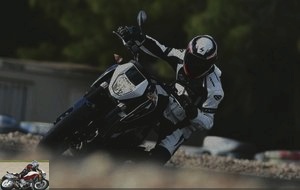
Each year seems to see the KTM brand breaking new records, both economic and sporting. 2015 thus saw the group’s turnover rise to one billion euros, giving the Austrian manufacturer first place in Europe. He likes to point out that its success is based on a very strong investment in R&D (research and development) as well as on numerous innovations. On the competition side, 7 titles have been added to the already well-stocked trophy racks and MotoGP is in the line of sight with the RC16 ….
But this dynamic, the firm of Mattighofen also owes it in large part to the success of its emblematic Duke. Available in 125, 200, 390, 690 and 1290, the Duke range is one of a kind and the backbone of the KTM company. This is to say its importance. And LC4-powered machines are the cornerstone of the family, with more than 68,000 units sold since 2007.
As Thomas Kuttruf, Head of Press Relations, points out, "Duke and R&D are the financial engines of the Austrian company". As proof, the manufacturer has brought no less than 45 machines to the island of Grand Canaria for this press launch. !
The reign of the Duchesses began in 1994. Specializing in all terrain, the Austrian manufacturer decided to tackle the road segment. The first model is a vaguely civilized supermoto. Its version of 1998, Duke 2 cubing 640 cm3 aesthetically approached a street trail.
For the family, everything accelerated in terms of style and ergonomics in 2007, with the design of the 690 Stunt concept by Kiska, head of style at KTM. This laid the important foundations for the image and future success of the range. Thus the lines of the plunging and wide sides (beginning of protection) and the shape of the saddle (rider "in" the motorcycle and no longer "on" it), definitively anchor the machines in the road range..
So it is with the Duke III and its LC4 single cylinder that the machine sets new standards in the roadster segment. Aggressive road styling but intact KTM genetics, the machine mutated again in 2012 to further refine and equip itself like a big one. This series 2 has an ABS, an anti-dribble clutch and still displays 3 kg less than its predecessor !
And for 2016, KTM pushes the concept even further, adding to improved mechanics numerous electronic assistance. to his Duke LC4 series 3
Discovery
The 690 model particularly synthesizes the image of the manufacturer from Matighoffen and the evolution of "LA" Duke, combining respect for origins and ultra-modernity. Thus, if it retains a single-cylinder core, it is a block optimized for each vintage and developed to the highest level of technicality that powers the roadster. This promises to be a new benchmark, with now a substantial electronic offer, optimizing the dynamic qualities of the 690 Duke and 690 Duke R. Because since 2012, an over-equipped quasi twin has accompanied the standard model..
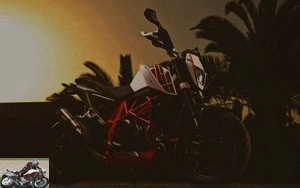
The sisters have in common a racy aesthetic, dressed in sharp angles. Graceful and narrow, their appearance alone evokes lightness and dynamism. Barely modified aesthetically, the machines are adorned with essentials. Short dressed, only the angular 14-liter tank, with taut lines and flat plunging in scoops, comes to dress their ostentatious structure. A new double-saddle saddle rests on the rear loop made of a single block of aluminum weighing just 4 kilos. Its notches house the air box with the translucent cover.
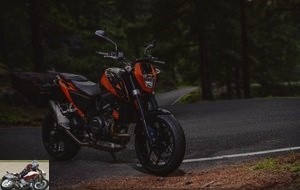
To differentiate the sisters from afar, we can first trust the color of their dress. White or orange with a black frame, it is a standard.
Delivered black on an orange frame, it is an R. The thin LED flashing lights of the latter already augur a more efficient equipment than that of its sister, with more common cabochons. Sharing mechanics and chassis, the Duke then diverge mainly in suspensions and electronics. What we detail in the Technical section where you will also find the remarkable mechanical innovations brought to the uni-cylinder.
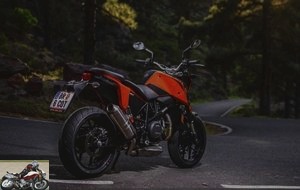
Technical
KTM 690 Duke standard and R are based on the same basis, unchanged. "Less is more" is a motto that would apply easily to the acetic duchesses. With one kilogram lost on the previous model, the aristocratic athletes weigh 148.5 and 147.5 kg (model R) dry on the scales. A sturdy 9 kilogram chrome molybdenum steel trellis frame supports the 690cc LC4 single cylinder. This one sees its high engine strongly redesigned.
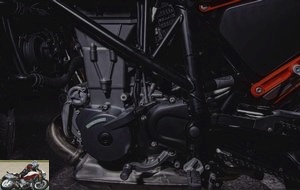
The cylinder head indeed contains many innovations and remarkable details of ingenuity. The first of these consists of the presence of a balancing arm mounted on a secondary shaft in order to reduce vibrations. The timing chain therefore displays a new kinematics, actuating both the three camshaft but also this new counterbalance secondary shaft. The drive pinion of the former incorporates a decompression lever passing through it to facilitate starting. The centrifugal force then disengages the system…. A force which also serves, on the new shaft, to release the excess air pressure which can slow down the descent of the piston. The rotating mass is pierced at its ends to its hollow shaft, creating a suction like a vortex. The air is then led out of the cylinder head. And without shipping the oil !
A central cam drives the exhaust valves via a new two-finger rocker. This oscillating part forged and treated with DLC (Diamond Like Carbon) requires multiple manufacturing operations. Two outer cams control the intake valves via two small push buttons. Between them, a removable part allows them to be moved very easily in order to adjust the valve clearance. This excellent accessibility simplifies maintenance. Finally, a resonator, near the intake, improves volumetric efficiency and counteracts wave effects..
But the single cylinder also sees its bore pushed to 105 mm (+ 3 mm) and its stroke reduced to 80 mm (- 4.5 mm). Still wider, its forged piston retains the same weight, pushed by a lighter connecting rod. And the double ignition with individual mapping is renewed. In short, the block is even sportier, gaining no less than 1,000 laps over its useful power range. This increases by 7% at 8000 rpm, rising to 73 hp on the 690 Duke and 75 hp for the R and its Akrapovic titanium exhaust…. The mufflers of the two machines have also been reworked, losing a kilo each and improving their sound and engine power. The torque is not left out, now showing 7.4 da.Nm at 6500 revolutions..
Sport requires the clutch is limited slip, allowing entry into muscular turns with stacking of report. And the lever is activated almost visually, it is so flexible.
Like its predecessor, the new Duke benefits from advanced electronics to exploit its performance. And the differences between the two models are clearly visible. Ride By Wire type, the accelerator manages only one injection map (Street) on the standard machine. The optional Track Pack at 299 € allows you to add two other modes (Sport and Rain) and especially more advanced assistance: traction control (TC), engine brake regulator (MSR), as well as a Supermoto mode for doping its ABS already disconnectable.
His twin Rogue benefits of course from this set but adds, still as standard, a stability control (MSC) managing the assistance in more detail. Clearly, it detects the angle of inclination of the motorcycle, fiercely optimizing the efficiency of the systems. It will thus be less apprehensive to screw the throttle grip on the angle or take the brake lever there. Because the Duke R doesn’t shy away from retarders either, sporting a four-piston, radial-mounted Brembo monobloc M50 front caliper. Under the pressure of a master cylinder of the same type, the clamp attacks a 320 mm disc. The standard sister is "content" with less extreme equipment. The rear system receives a single piston caliper for a 240mm disc. And both machines have a Bosch 9M + disconnectable two-way ABS, managing the rotation of the 17-inch rims. Metzeler Sportech M7 RR covers fit them, promising a worry-free grip.
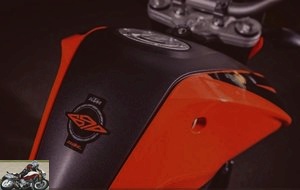
Giving preference to liveliness, the geometry barely evolves. Thus, the column angle remains at 26.5% but the fork tubes move back into the tees, reducing the fork offset by 4 mm. With more hunting, the machine should gain more stability on the angle. As for the distribution of the masses, with their catalyst placed under the engine, the Dukes try to play the light rocker..
To stick to the bitumen, the Duke R is fitted with a 43 mm WP inverted fork, fully adjustable in compression and rebound, with differentiated adjustment by wheel on each tube. The shock absorber is of the same type, with a separate cylinder, raising the rear by 30 mm. Both travel 150 mm for optimized ground clearance. The sister is less ruinous, snubbing the settings and reducing the strokes to 135 mm. Finally, the boxed aluminum swing arm (6 kg) completes the signature, for the two sisters, of a high-end equipment where performance takes precedence..
In the saddle
Entirely redesigned, the seats are more attractive. The rider saddle, narrow, gives even more ease to move on the machine. But here too, the bogus binoculars differ greatly in ergonomics. With 865 mm in height, the Duke 690 R offers a seat 30 mm higher than that of the standard because of its suspensions. Rather usual on the latter, the flexion of the legs is much more marked on the Duke "Racing". Set back and raised footrests clearly tilt the body on a less arched handlebars. The support of the wrists is much sharper, preparing for arousal. While admiring the triple tree cut in the mass of the Rageuse, or that forged of the other, the gaze falls on the new instruments. Or rather, the TFT screen grouping them together. The main display features a tachometer surmounted by a bargraph-type tachometer, alongside the gear indicator, fuel and engine temperature gauges, the selected map, two-part odometer and exterior temperature. On the left stalk, a four-button console allows you to view the menus and modify their parameters: General information, Trip 1 and 2, engine mapping, ABS / MTC adjustment and still the very practical Favorites mode.
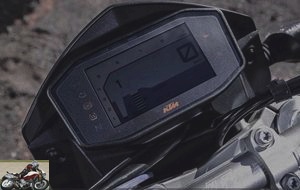
Two complaints about this equipment: it does not store the map or the ABS parameters in memory, reverting to the default setting each time the ignition is switched off with the key. Equally regrettable, the display remains fixed on the last menu consulted, without automatic return to the main screen..
In the city
Instantly awake, the uni-cylinder crackles at the slightest rotation of the right handle. Its slow-motion heave then instantly mutates into a metallic rumble. Duller than on the old model, these vocalizations are further magnified by the Akrapovic silencer of the R version.
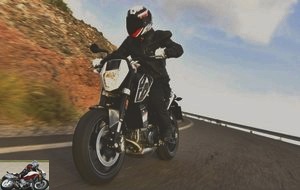
The machine sets off, immediately demonstrating its lightness and rare agility. On its handlebars, moving between vehicles becomes a game of every moment. Its size of 125 led by smart mechanics is no stranger to it..
At medium speed, the vibrations are effectively more contained than on the old model. Likewise, the availability of mono from 2,800 laps makes it possible to maintain the urban look in third gear. Always astonishing flexibility for this engine. In fact, everything on board is surprisingly smooth. Control, selection, mechanics, the 690 Duke seem well polished, perfectly playing the role of everyday steed. But the slender athletes are hardly home-like and only wait for a clearer horizon to drop the city costume and take out the leather from the arsenal..
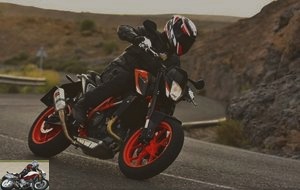
Motorways and expressways
Explosive, the LC4 leaps without restraint towards high revs, rushing on the smooth asphalt of multiple tracks to assault the tachometer. The propensity of the block to push over the entire engine range without ever slackening is intact. And with 1,000 revolutions gained, the breaker now only intervenes at 10,000 revolutions! Is it really a single cylinder that catapults these machines? At nearly 190 km / h, achieved without difficulty, we remain amazed at the sporting capabilities of the block. And the course is flawless even if the front end remains sharp. Even more stable, the Duke R benefits from its upper cycle part.
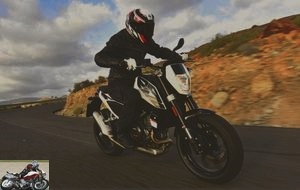
Leaving high speeds, the regime is established at 6,000 revolutions for the legal motorway. There again, the vibrations are ample, maintained in acceptable frequencies without more painful tingling on long journeys. Of course, you have to deal with the absence of any deflector, a straight handlebar and a suitable position. Enough to shorten the use of priced soothing ribbons and take an otherwise more rhythmic tangent.
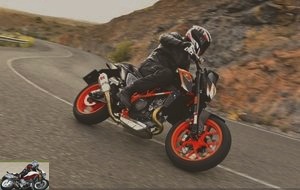
Departmental
Virtuosos of the secondary network, the Dukes finally find their favorite playground there. Mechanics and cycle parts go hand in hand to decipher the twirling partition of the Canary Islands roads. Carried away by their supercharged mono, the sisters attack the ring without weakening. A support on the handlebars, another on the footrest and the duchesses are taken to the eye on the chosen trajectory. Passing from one turn to the other without downtime, the Duke print an allegro massimo tropo rhythm. On narrow mountainous roads we do not force the handlebars at all, the bike engaging by itself in a curve, even when approached on the brakes..
On board the standard model, precision and stability are less evident when the bitumen degrades. At a good pace on the bumpy, the shock absorber pumps and the Duchess moves her rear end in bends. More stylish, the R plays on the flying carpet with its adjustable WP suspensions, playing on the roughness and other defects approached on the angle. Advantageously positioned on the attack, its pilot naturally seeks confusion and sporting trajectories.
But both take full advantage of their block of character. From 6,500 laps, the block strongly revived the crew. Its weight / performance ratio gives it serious arguments for uninhibited piloting. And the Austrians accompany their waltz with much less mundane music. Hoarse and metallic, the escapement underlines the dancing evolutions of the sisters in full effort. Already responsive in Street mode, the Dukes are even nastier with the Sport mapping. The latter gives free rein to the liveliness of the engine. Conversely, Rain muzzles reminders for secure evolutions.
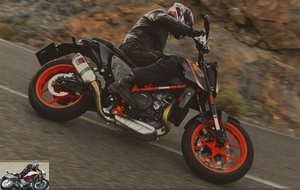
Without ever weakening, the mono works the Metzeler Sportech M7 RR which sometimes slip away under its ridges. Vigilant, the traction control reduces slippage with the Track pack option and particularly on the R version equipped with angle grip analysis.
This electronics is just as effective and appreciable for brake management. Because the most rupine of Duke brakes hard. Very strong. The more playful will appreciate the Supermoto ABS mode leaving the rear wheel free to slide on demand. Especially since the limited slip clutch makes it possible to stack the reports at the end of the right lanyard. Finally, on the most important decelerations, the MSR regulates the torque that can block the drive wheel. Limiting the engine brake by slightly opening the intake straw, the system can sometimes surprise, giving the impression that the mechanics are still towing.
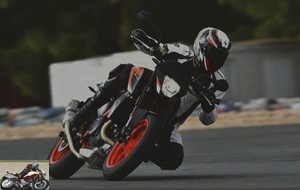
Circuit
A quick passage on the track shows again the difference between the sisters of Mattighofen. The typical position of the R model gives greater ease on the circuit, also greatly optimizing ground clearance. Likewise, its powerful brake equipment makes it take the lever much later than on board its sister. And mass transfers are managed more finely thanks to its adjustable suspension.
Likewise, its electronics are working hard to transcend the sporty uni-cylinder roadster. Furious in the towers, the block devoid of inertia propels the Duke R vigorously out of a curve, under the supervision of the TC. Perfectly staged, the box participates in the approval even if we regret the absence of shifter, unavailable as an option.
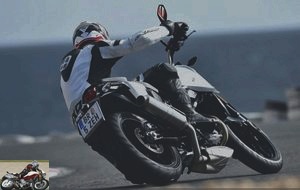
Part-cycle
While performing well on both Dukes, the R’s adjustable WP elements are significantly superior in all phases of riding. More restless but still healthy, the standard requires a little more restraint in the bleeding attack on the goat road.
Braking
With its top-of-the-range Brembo M50 caliper, the 690 Duke R delivers powerful and particularly flexible decelerations. His sister is doing a little less well, of course. But here we compare the excellent and the best.
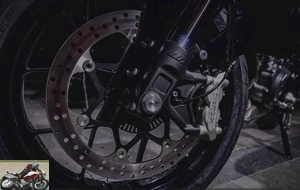
On the road, the rear clamp usefully completes the system and the ABS remains discreet on the track.
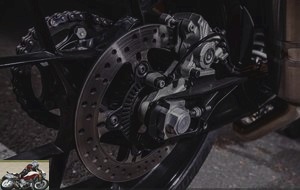
Comfort Duo
For their pilot, the KTM 690 Duke and R are more pleasant due to improved seating. And the vibration reduction is noticeable. Coupled with their suspension, this set allows you to enjoy the duchesses on a daily basis or a little more in the long court.
High perched, the passenger footrests hardly make the duo obvious, except for a very short distance. Handles are assigned to the passenger but, almost in line with the body, does not help to feel comfortable.
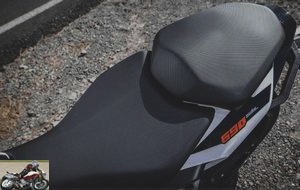
Conclusion
Iconoclastic, peerless, the 690 Duke and 690 Duke R are relaunched again with this ever more effective opus. Uncluttered, the Duchesses however make up a refined whole, both in terms of mechanics and part cycle equipment and construction. More than ever, they are the frames of connoisseurs and amateurs of achievements combining apparent simplicity and high technology. Thus, the LC4 unit is renewed again to combine power and efficiency. It now boosts its performance with controlled electronics and digital instruments are also appreciable and readable.
KTM does, however, contain the price of its fake binoculars. With € 7,990 and € 10,500 respectively, 690 Duke standard and 690 Duke R are invoicing their high-level realization, unparalleled single-cylinder technology and quality equipment. Machines of course eligible for the A2 license, with power reduction kit.
Suitable for any purpose, Austrian frames more than ever deserve the attention they deserve. It’s up to you to rediscover the charms of big mono fun in a performance setting.
Strong points
- Evidence of handling
- Engine character at half speed
- Agility and precision of the chassis
- Ergonomics
- Electronic assistance especially on R
- Quality suspension on the R
- Flattering sound
Weak points
- Front axle responsive to high-speed motion
- High engine speeds less brilliant
The technical sheet of the KTM Duke 690
The differences
KTM Duke 690
Non-adjustable WP suspension
ABS
Street mapping
With Track Pack at 299 €
Two additional Race and Wet modes
Traction control
ABS Supermoto
MSR engine brake control
KTM 690 Duke R
Full adjustable WP suspensions
Stability control for ABS, TC and MSR
ABS Supermoto
Three engine maps (Street, Race, Wet).
Colors
690 Duke: Black or Orange, black frame
690 Duke R: Black, orange frame
Related articles
-
Vintage 2019! Even better than before ! V-Twin LC8 а 75 °, 1.301 cm3, 175 hp and 141 Nm, 209 kg, semi-active suspensions WP Happy New Year for KTM which…
-
At maturity If the Duke 3 was an exotic outsider against classic roadsters, this fourth generation largely deserves its place in the family and is a…
-
Test of KTM Duke 125, 200, 390, 690, 690 R and 1290 Super Duke R With a 2014 record year in terms of sales, the Austrian manufacturer is inaugurating an…
-
KTM 1290 Super Duke R motorcycle test
Feel it ! 180 hp, 189 kg dry, 140 Nm of torque, 18,199 euros The grasshopper and the ant … The flamboyance of the first masks the truth of the ardor of…
-
Beautiful and rebellious: 125 cm3 of vitamin orange The long-awaited 125 Duke is finally on display. A project in progress since 2008, this new model…
-
Light is Right ! The little Duke 390 is an amazing machine. Ultra light and very powerful without being radical, it comes to hunt on the lands of the…
-
125, 390, 690, 990, 1290 and now 200! KTM does not stop declining its flagship roadster, this time with this small displacement of 200 cm3. Made in India…
-
A remarkable entry for KTM in the most profitable segment of the market Inline twin, 799 cc, 105 hp at 9000 rpm, 87 Nm at 8000 rpm, 169 kilos, from ¤…
-
Duchess of competition 125 Duke, 200 Duke then 390 Duke, the Austrian manufacturer has been dynamically investing the small-displacement market since…
-
Biker test: Frantz THE DUKE I as they should have released it in ‘95: now the SUPERMOTO exists I wanted to preserve the plastics in their excellent…
Conso ?
Tank capacity?
Hello too ! How are you ?
The tank capacity has not changed: it is still 20 liters, but with the work done on the maps and the exhaust, Triumph announces a consumption down 5%. However, it is always difficult to talk about drink after a press presentation, because in general we do not refuel ourselves and in addition, we often ride like pigs. Suddenly, I had an indication at the ODB: 7.3 l / 100. To be confirmed during another run, because it is sure that we can do a lot less.
There you are…
With that, good day, good morning to you, bikers greetings, etc, etc,
PG
I like it !
I had the old Tiger 1050. Purchased new, from the start it didn’t want to start (battery HS and that had caused an electronic problem!), Then clutch which "grazed" (taken under warranty).
The lighting sucked and I scared myself driving at night !
Other than that, it was pretty good, light, good handling, comfortable, good engine …
The news had to be improved regarding the negatives I guess.
___
A comparison would be welcome, I think, with its ” sister ”, the TRIUMPH Tiger Adventure XC (Mouture 2016) …
Comparison with the Versys 1000, MT09 Tracer and BMW S1000XR (and Multistrada 1200?) Instead
The 1050 has nothing to do with the 1200, it is much more road and sporty